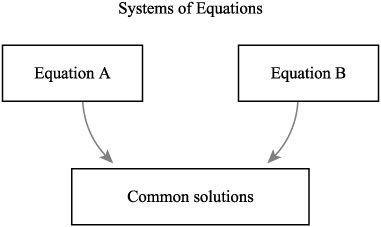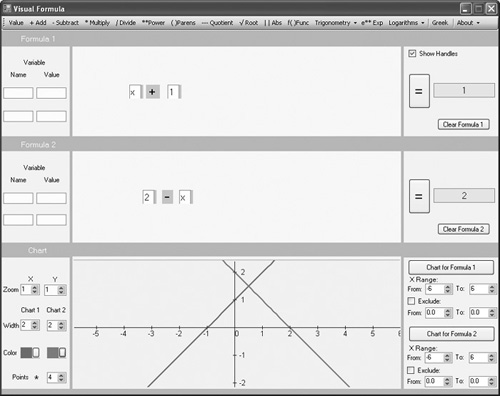Shared Solutions
As Figure 11.1 illustrates, when two or more equations can generate the same sets of ordered pairs, they form a system of equations. When you solve a system of equations, you find sets of values that both equations generate. You can approach solving systems of equations in various ways. One way is to generate ordered pairs, and then compare the ordered pairs to determine if any are the same for both equations. Another approach involves generating graphs for the equations that you plot on one Cartesian coordinate plane and then compare. If you are working with linear equations, the point at which the lines intersect constitutes a solution for the system of equations.
Figure 11.1. One ordered pair can be a solution to two or more equations.

Any given equation is likely to generate an indefinite number of ordered pairs. The ordered pair that a given equation generates is a solution set. As with any two sets, if the sets share common elements, then the shared elements are known as the intersection of the two sets. Consider this set of equations:
y - x = 1
y + x = 2
Given this set of equations, you can then ask whether a coordinate pair exists that satisfies both equations. To apply the graphical approach to answering this question, you can use Visual Formula to implement the equations and generate graphs of them. To implement the equations in Visual Formula, you must rewrite them in this way:
y = x + 1
y = 2 - x
Figure 11.2 illustrates these equations as implemented in Visual Formula. For both equations, you create two Value fields. In the top equation, you use the Add menu item to position a plus sign between the fields. For the lower equation, you use the Subtract menu item to position a minus sign between the fields. You type the variable x and the constant values as shown. You can then click on the Chart Formula 1 and Chart Formula 2 buttons to generate the graph. In the left panel, you change the Color and Width fields for the lines to achieve the effects shown.
Figure 11.2. The intersection of the two lines constitutes the intersection of the solution sets of the two equations.

When you inspect the point of intersection between the two lines in Figure 11.2, you can assess that the solution pair is likely to be (0.5, 1.5). To test these values, you insert them into the equations. The test for the first equation shows the pair to be valid:
y - x = 1
1.5 - 0.5 = 1
1 = 1
The test for the second equation also shows the pair to be valid:
y + x = 2
1.5 + 0.5 = 2
2 = 2
